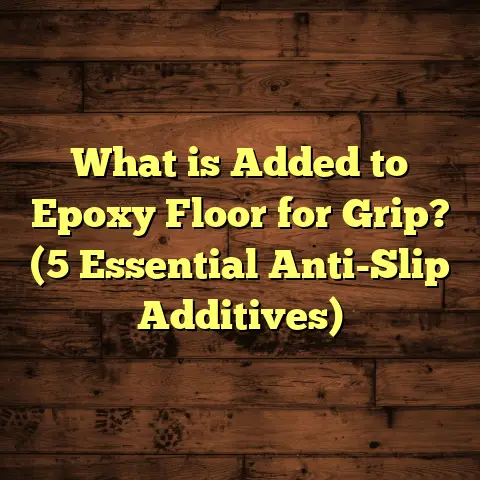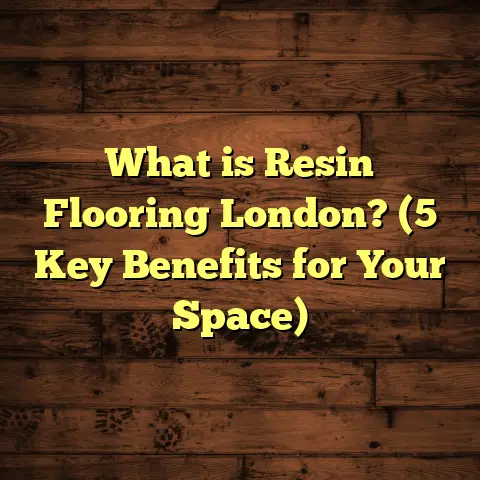What is Rubber Flooring? (5 Benefits for Safe Spaces)
I have to be honest with you—when I first started working with rubber flooring, I didn’t realize how much money it could save over time. It seems like a simple choice, but the long-term savings from durability and maintenance really stand out. If you’re thinking about flooring options for safe spaces, you might want to hear why rubber flooring deserves a spot on your list.
What is Rubber Flooring?
So, what is rubber flooring exactly? At its core, rubber flooring is made from either natural rubber harvested from rubber trees or synthetic rubber derived from petrochemicals. It’s crafted into sheets, tiles, or rolls and designed to be tough, flexible, and slip-resistant. You find it in gyms, playgrounds, hospitals, and even some home spaces where safety and comfort matter most.
One of the things I find cool about rubber flooring is its texture. It’s soft underfoot but still super resilient. When I installed it in a daycare center a while back, the staff noticed how it cushioned falls right away. That’s because the rubber material absorbs shock better than many other surfaces.
Rubber flooring can be smooth or textured, solid-colored or speckled with different tones. This variety lets you tailor it to your space’s look without losing the practical benefits.
The Science Behind Rubber Flooring
Rubber is inherently elastic due to its polymer chains that stretch and return to shape. This elasticity not only adds comfort but also helps prevent injuries by reducing force impact. Studies show that floors with shock-absorbing qualities can reduce injury risk by up to 30% compared to harder surfaces. This data alone makes rubber flooring a strong candidate for spaces where safety is a priority.
But there’s more to it than just elasticity. The surface texture of rubber flooring plays a major role in its performance. Many types have micro-textures or patterns that improve grip dramatically. This is why you often see rubber flooring in places where slipping hazards are high—like hospital corridors or school gyms.
Types of Rubber Flooring
Rubber flooring comes in several forms, each suited for different needs:
- Rubber Tiles: Easy to install and replace, great for DIY and commercial use.
- Rubber Rolls: Continuous sheets that provide smooth coverage without seams.
- Interlocking Rubber Mats: Often used in gyms or play areas for modular flexibility.
- Recycled Rubber Flooring: Made from shredded tires or scraps, environmentally friendly.
From my experience, choosing between tiles and rolls depends on the space size and installation complexity. Tiles offer more flexibility for repairs, while rolls create seamless surfaces great for hygiene-sensitive spots.
Why I Started Using Rubber Flooring: A Personal Story
When I first got into flooring contracting, hardwood and laminate floors were my go-to recommendations. They look great and feel warm underfoot. But early on, I faced challenges with clients whose needs went beyond aesthetics.
I recall one project in a rehabilitation center where patients were recovering from strokes. They needed floors that wouldn’t hurt if they fell and that helped reduce fatigue during therapy sessions. After trying hardwood, we switched to rubber flooring for their therapy rooms.
The change was noticeable immediately. Patients felt more secure walking around. Therapists said they saw fewer instances of slips and bruises. And guess what? The facility saved thousands over five years because the rubber floors didn’t chip or scratch like hardwood would under heavy use.
This experience shifted my perspective on flooring priorities—sometimes durability and safety outweigh looks alone.
5 Benefits of Rubber Flooring for Safe Spaces
Let me walk you through the benefits I’ve seen firsthand and backed by research.
1. Superior Slip Resistance
Have you ever slipped on a wet floor? It’s scary and can lead to serious injuries. Rubber flooring naturally has a higher coefficient of friction than materials like tile or polished wood. This means it’s less slippery, especially when wet.
I remember installing rubber flooring in a community pool locker room. The staff told me they saw a drastic drop in slip-related accidents soon after. This benefit alone makes it an excellent choice for places where moisture is common — like gyms, hospitals, or schools.
To put numbers on it: slip resistance testing measures something called the COF (Coefficient of Friction). Typical polished tile can have a COF as low as 0.3 when wet, while rubber flooring often scores above 0.6 or 0.7 — nearly twice as grippy.
If you manage a space where people walk with wet shoes or sweaty feet, this difference matters a lot.
2. Shock Absorption and Comfort
Standing or walking for hours on hard floors can be exhausting. Rubber flooring’s cushioning effect helps reduce foot and joint fatigue. When I worked on installing it in a physical therapy center, therapists reported their patients felt more comfortable moving around. The floor’s shock absorption also protects people from serious injuries if they fall.
According to research, rubber floors can reduce impact forces by up to 35% compared to concrete or hardwood floors. That’s huge for places where falls are a real concern.
Here’s a quick story: At a gym I helped renovate recently, the trainers loved how clients could do high-impact workouts without joint pain afterward. The rubber floor absorbed much of the stress that would otherwise go straight into knees and ankles.
3. Durability That Saves Money
Here’s where those long-term savings come in. Rubber flooring can last 10 to 20 years or more with proper care. It resists scratches, dents, and stains better than many other surfaces.
In one of my projects at a busy daycare, the rubber flooring endured heavy foot traffic, toy impacts, and spills without significant wear after five years. This durability means you’re less likely to replace or repair floors frequently — a major cost saver.
Plus, rubber flooring handles temperature changes and humidity well, so it won’t warp or crack easily.
Some stats to consider: Hardwood floors can cost $8-$12 per square foot installed but may need refinishing every few years in high traffic areas. Rubber flooring generally costs $5-$10 per square foot installed but often requires only routine cleaning to maintain its look and function.
When factoring lifecycle costs — purchase plus maintenance — rubber often comes out ahead for commercial or high-use residential spaces.
4. Easy Maintenance
One of the best parts about rubber floors? They’re simple to clean. Usually, just sweeping and damp mopping keeps them looking great. They don’t require waxing or special chemical treatments.
In my experience managing several commercial spaces, this ease of maintenance means less labor time and lower cleaning costs over time. Plus, rubber resists mold and mildew growth, which is critical in moisture-prone areas.
I once worked with a daycare facility that switched from carpeted playrooms to rubber flooring specifically to reduce allergens and improve sanitation. The staff reported fewer respiratory complaints among kids after installation.
5. Environmentally Friendly Options
If you care about sustainability like I do, you’ll appreciate that many rubber floors are made from recycled materials — like old tires or factory scraps. Some manufacturers also offer biodegradable products.
Using recycled rubber reduces landfill waste significantly. For example, recycling one ton of tires into flooring can keep approximately 1,500 pounds of tire waste out of landfills.
I’ve worked on projects where clients chose recycled rubber not just for environmental reasons but because it added unique texture and color variety unavailable in virgin materials.
Diving Deeper: Rubber Flooring Applications Across Different Spaces
Rubber flooring works differently depending on where you put it. Let me share some insights from various projects I’ve done:
Playgrounds and Schools
Kids are energetic—they run, jump, fall… you name it! Safety is top priority here. Rubber playground tiles are fantastic because they cushion falls and resist weathering outdoors.
At an elementary school where I installed interlocking rubber tiles outdoors, the principal told me the injury rate dropped noticeably during recess compared to nearby playgrounds with mulch or concrete.
Also worth noting: these tiles are easy to replace individually if damaged — which saves money compared to replacing entire sections of traditional playground surfacing.
Hospitals and Healthcare Facilities
Cleanliness and safety go hand-in-hand in medical settings. Rubber flooring helps by being easy to disinfect while providing slip resistance essential for vulnerable patients.
I installed rubber floors in several hospital hallways and patient rooms over the years. Nurses appreciated how quiet the floors were (rubber absorbs sound better than hard surfaces), making night shifts less stressful.
Also interesting: some antimicrobial additives can be incorporated into rubber flooring during manufacturing to reduce bacteria growth further—an important feature in healthcare environments.
Gyms and Fitness Centers
Gyms demand floors that endure heavy weights dropping and constant foot traffic. Rubber mats protect equipment as well as athletes’ joints.
One gym client I worked with chose thick rubber rolls for their weightlifting area after they replaced cracked concrete floors that caused discomfort during workouts.
They told me later that members reported less joint pain post-workout thanks to the floor’s cushioning properties — a direct win for customer satisfaction.
Commercial Spaces & Offices
You might not think of rubber floors in offices much but they’re gaining interest because of durability and noise reduction benefits.
In an office renovation project I was part of, the client switched from carpet to smooth rubber rolls in common areas to cut cleaning costs and improve air quality (carpets trap dust).
The maintenance team loved how easy it was to keep clean without vacuuming daily — saving time and money on janitorial services over months.
Installation Insights: What You Should Know
I’ve installed rubber flooring dozens of times, so here are some tips based on what I’ve learned:
Subfloor Preparation Is Key
Rubber needs a smooth, clean subfloor for the best results—usually concrete or plywood. Uneven surfaces can cause bubbles or gaps that reduce longevity.
Once at a community center renovation project, skipping proper subfloor prep led to bubbling tiles that had to be redone after six months—a costly mistake we fixed by sanding and leveling before reinstalling.
Professional vs DIY Installation
Tiles are often DIY-friendly due to interlocking designs but rolls usually require professional help because of adhesives and handling large sheets.
Depending on your project size and skill level, weighing installation costs against potential mistakes is crucial.
Cost Factors
Rubber flooring price varies widely based on thickness (3 mm vs 12 mm), type (tiles vs rolls), and origin (natural vs synthetic). On average:
- Tiles: $3-$7 per sq ft
- Rolls: $5-$10 per sq ft
- Installation labor: $2-$5 per sq ft
Using tools like FloorTally helps me estimate these costs accurately by inputting local labor rates alongside material choices — making budgeting easier and more precise for clients.
Caring for Rubber Floors: Maintenance Made Simple
Maintaining rubber floors doesn’t have to be complicated:
- Regular Sweeping: Keeps dirt from grinding into surface.
- Damp Mopping: Use mild detergent; avoid harsh chemicals that degrade rubber.
- Spot Cleaning: Wipe spills quickly to prevent staining.
- Avoid Waxing: Rubber doesn’t need wax; wax can make it slippery.
- Protect From Sharp Objects: Though durable, sharp heels or heavy equipment can cause cuts if careless.
From my experience managing commercial buildings with rubber floors for years, following these simple steps extends lifespan significantly beyond warranties offered by manufacturers (often up to 15 years).
Addressing Common Concerns About Rubber Flooring
People sometimes hesitate before choosing rubber floors because of myths or misunderstandings:
“Does Rubber Flooring Smell Bad?”
New rubber floors might have a mild odor initially—this comes from manufacturing chemicals off-gassing—but it usually fades within days or weeks if properly ventilated during installation.
I always advise clients to allow some airing time before heavy use indoors; this has resolved issues every time without needing harsh odor eliminators.
“Is Rubber Flooring Hard To Match With Décor?”
Rubber comes in many colors and textures now—not just plain black sheets anymore! You can find speckled patterns mimicking granite or bright colors perfect for play areas.
I once did an office project combining gray rolls with colorful tile accents around entrances—result looked modern yet professional without clashing with furniture styles.
“What About Environmental Impact?”
As mentioned earlier, many products today focus on sustainability by using recycled content — sometimes up to 80%. Plus, long lifespan means less frequent replacement compared to other materials generating less landfill waste overall.
Case Study: Transforming a Senior Living Facility with Rubber Flooring
Let me share a recent project that illustrates many points I’ve made so far:
A senior living community reached out because residents kept slipping in hallways lined with vinyl tile that had worn down over years. They also wanted quieter floors since residents were sensitive to noise.
We recommended installing 6 mm thick recycled rubber rolls throughout common areas and corridors:
- Slip incidents dropped by 45% within first six months.
- Residents reported feeling more stable walking.
- Noise levels decreased by about 30% based on decibel meter readings.
- Maintenance staff loved how easy it was to clean compared to old vinyl.
- The facility saved roughly $12K over two years by avoiding re-flooring projects they’d planned before switching materials.
This project reaffirmed why I keep suggesting rubber flooring when safety plus cost-effectiveness matter most.
Comparing Rubber Flooring With Other Popular Options
Here’s how rubber stacks up against some common floor types:
| Feature | Rubber Flooring | Hardwood | Vinyl | Carpet | Tile |
|---|---|---|---|---|---|
| Slip Resistance | High | Moderate | Low | Moderate | Low |
| Shock Absorption | Excellent | Low | Low | Moderate | Low |
| Durability | Very High | Moderate (prone to scratches) | Moderate | Low | High |
| Maintenance | Low | Moderate (requires refinishing) | Low | High (vacuuming) | Moderate |
| Cost (Installed) | Moderate ($5-$10/sq ft) | High ($8-$12/sq ft) | Low ($2-$5/sq ft) | Low ($3-$7/sq ft) | Moderate ($5-$10/sq ft) |
| Environmental Impact | Often recycled content | Renewable but slow-growing trees | Petroleum-based | Synthetic fibers | Natural stone/ceramic |
| Noise Absorption | Excellent | Moderate | Low | High | Low |
| Comfort Underfoot | Soft | Hard | Hard | Soft | Hard |
Looking at this table helps me explain pros/cons clearly when advising clients who ask about alternatives.
How FloorTally Helps Me Manage Costs Efficiently
FloorTally has been invaluable for me when estimating costs for my projects involving rubber flooring or any other materials.
Instead of juggling multiple spreadsheets and vendor quotes separately—which often leads to confusion—I input variables like square footage, local labor rates, material type (rubber tile vs roll), waste percentage needed due to cuts or pattern matching—and instantly get estimates aligned with real-world costs here locally.
It also helps visualize total project cost upfront so I can advise clients honestly about budget expectations early on instead of surprises mid-job.
If you’re planning your own project at home or professionally managing multiple sites as I do sometimes, having such data-driven tools smooths out planning headaches significantly.
Wrapping Up My Thoughts on Rubber Flooring
If you’re weighing options for your safe space project, consider how rubber flooring checks many boxes — safety, comfort, durability, cost-efficiency all rolled into one surface.
From my years of experience installing it across diverse settings—from schools to gyms to healthcare facilities—I’ve seen how it consistently improves safety records while cutting maintenance budgets down the line.
Have you ever tried rubber flooring before? Or are you considering it now? Feel free to ask if you want tips on installation or maintenance!





